How Can You Tell if Your Cat Is Lonely?
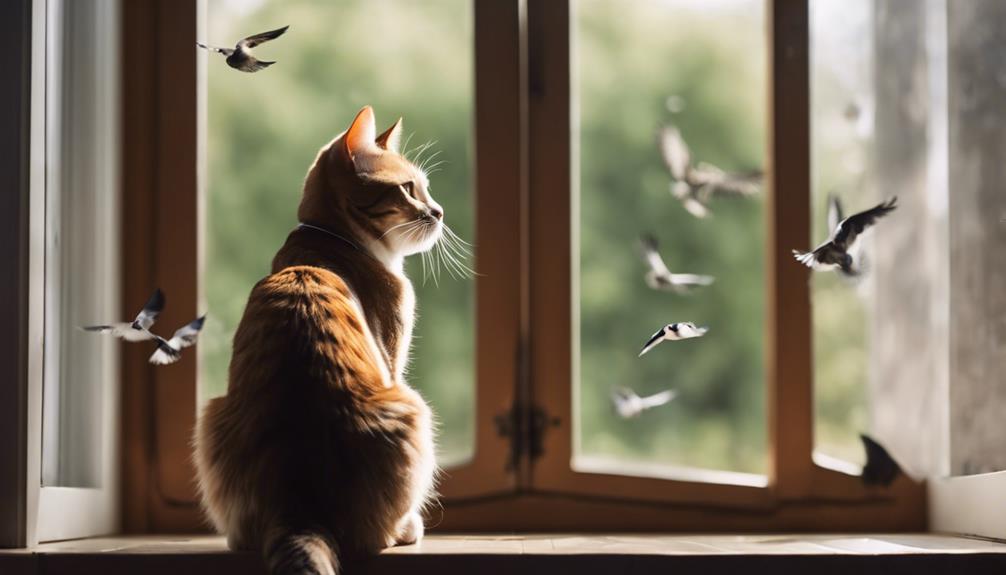
- Excessive vocalization and other subtle cues can indicate your cat is seeking more attention and companionship.
- Changes in behavior such as increased clinginess or withdrawal may also suggest loneliness.
- Destructive behavior, like scratching furniture or excessive grooming, could be a sign of loneliness in cats.
- Providing interactive toys, climbing structures, and spending quality time with your cat can help alleviate loneliness.
Behavioral Changes
How can you recognize if your cat is lonely through its behavioral changes? One key indicator is a shift in its playtime routine. Cats are typically playful animals, so a sudden lack of interest in interactive toys or a decrease in engaging in play activities could signal loneliness.
Interactive toys are especially important for stimulating a cat's mind and providing necessary mental and physical exercise. If a cat starts to show disinterest in these toys or becomes lethargic, it may be a sign of loneliness.
Monitoring changes in your cat's behavior is crucial in identifying loneliness. Cats are social creatures that thrive on interaction and companionship. When they lack these social stimuli, they may exhibit changes in their behavior. By paying attention to shifts in their playtime routine and engagement with interactive toys, cat owners can better understand their feline companions' emotional well-being and take steps to alleviate any loneliness they may be experiencing.
Excessive Vocalization
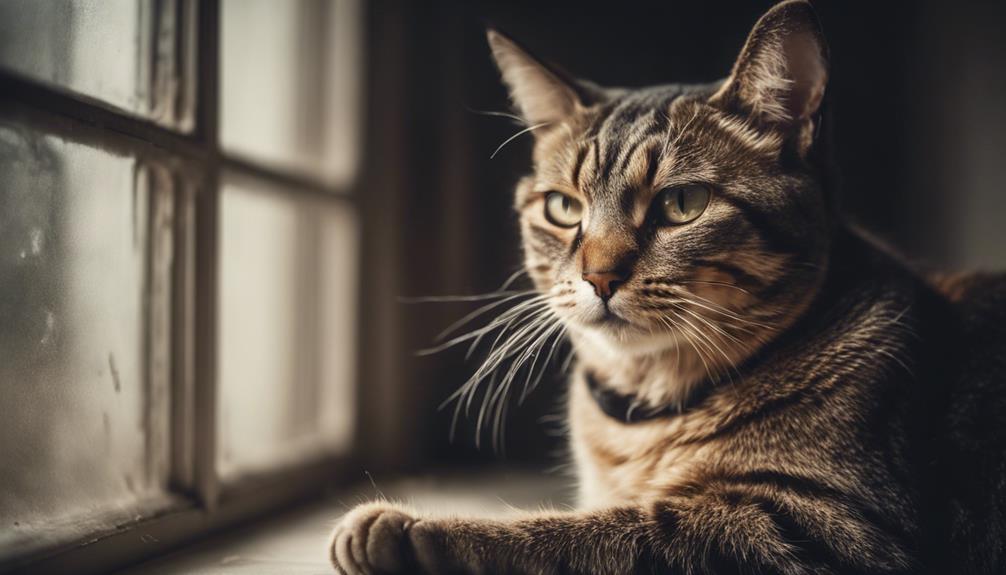
A cat experiencing loneliness may exhibit excessive vocalization as a form of seeking attention and companionship. Nighttime meowing is a common behavior seen in lonely cats. They may become more vocal during the night when the house is quiet, as this is the time when their need for companionship is most pronounced. This excessive vocalization can be their way of trying to communicate their feelings of isolation and desire for interaction.
When a cat is lonely, they often resort to attention-seeking behaviors, such as meowing excessively. This behavior can be a cry for companionship and a way for them to express their emotional state. It's essential for cat owners to understand the underlying reasons for excessive vocalization, as addressing the root cause of loneliness can help alleviate this behavior. Spending quality time with the cat, providing interactive toys, and creating a stimulating environment can all help reduce excessive vocalization and provide the companionship that a lonely cat craves.
Destructive Behavior
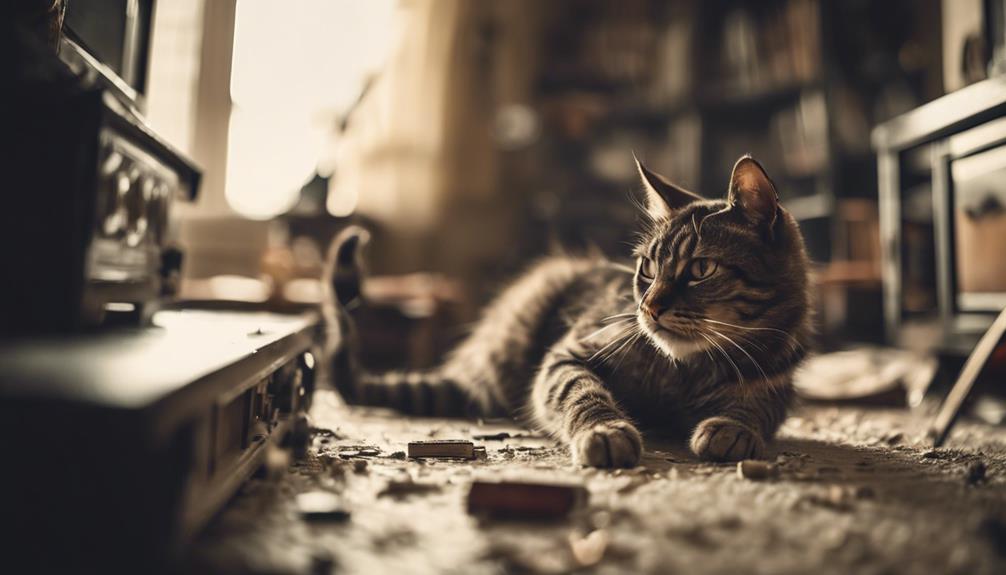
Cats experiencing loneliness may exhibit destructive behaviors such as:
- Scratching furniture
- Urinating outside the litter box
- Excessive grooming leading to hair loss
These actions can be a cry for attention or a way to cope with their feelings of isolation. Providing mental and physical stimulation, interactive play sessions, and creating a stimulating environment can help alleviate these destructive behaviors caused by loneliness.
Signs of Loneliness
Lonely cats may exhibit destructive behavior as a sign of their emotional distress. This behavior can include scratching furniture, excessive meowing, urinating outside the litter box, or even aggression towards their owners. Understanding these signs can help cat owners recognize when their feline friend is feeling lonely and in need of attention. Here is a table summarizing common signs of loneliness in cats:
| Signs of Loneliness | Description |
|---|---|
| Excessive Meowing | Constant vocalization |
| Destructive Scratching | Ruining furniture or carpets |
| Aggression | Unprovoked hostility |
| Inappropriate Elimination | Urinating outside the litter box |
Recognizing these signs early can help cat owners take steps to alleviate their cat's loneliness before it escalates.
Ways to Help
To address destructive behavior in cats exhibiting signs of loneliness, implementing environmental enrichment and interactive play can help redirect their focus and alleviate emotional distress.
Here are some ways to help:
- Interactive Toys: Providing toys that stimulate your cat's mind and encourage physical activity can prevent destructive behavior. Toys like puzzle feeders or laser pointers can keep them engaged and entertained.
- Playtime Schedule: Establishing a regular playtime schedule can ensure your cat receives dedicated attention and physical exercise. Engaging in interactive play sessions with your cat can strengthen your bond and provide them with the mental stimulation they need.
- Environmental Enrichment: Creating a stimulating environment with scratching posts, climbing structures, and hiding spots can offer your cat opportunities for exploration and play, reducing feelings of loneliness and boredom.
Litter Box Issues
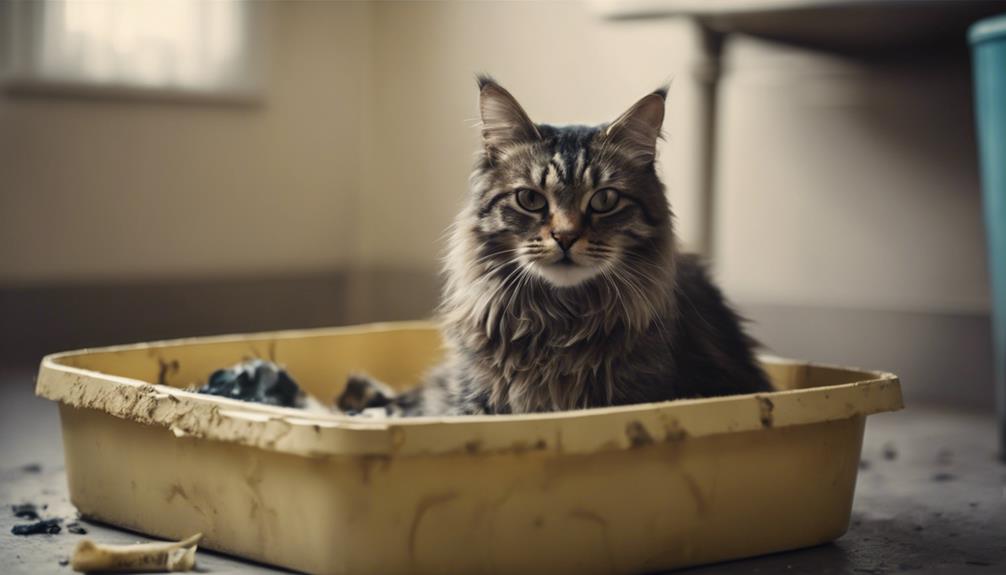
Cats experiencing loneliness may exhibit litter box issues such as not using the box or urinating outside of it. Changes in bathroom behavior can be a sign of stress or unhappiness in felines.
Providing multiple litter boxes in different locations can sometimes help address these problems.
Bathroom Behavior Changes
During times of loneliness or stress, cats may exhibit changes in their bathroom behavior, particularly in relation to their litter box usage. This can be concerning for cat owners, but understanding the reasons behind these changes can help address the underlying issues effectively. Here are some common bathroom behavior changes that may indicate your cat is experiencing anxiety or stress:
- Avoiding the Litter Box: Cats may start avoiding the litter box altogether when they feel lonely or stressed.
- Changes in Litter Box Habits: Look out for changes in your cat's frequency of using the litter box or sudden accidents outside the box.
- Excessive Digging or Covering: Cats experiencing stress may exhibit excessive digging or covering behaviors in the litter box.
Keeping an eye on these behaviors can provide valuable insights into your cat's emotional well-being.
Multiple Litter Boxes
Changes in a cat's bathroom behavior can often be addressed by considering the option of multiple litter boxes to help resolve any potential litter box issues. Proper litter box placement and size are crucial factors to consider. Cats may prefer separate areas for urination and defecation, so having multiple boxes in different locations can cater to their preferences.
Additionally, maintaining litter box cleanliness is essential to prevent aversion. Cats are meticulous animals and may avoid using a dirty litter box. Ensuring easy accessibility to litter boxes is also important, especially for older or arthritic cats. Placing litter boxes in quiet, low-traffic areas can provide a sense of security for cats while they do their business.
Withdrawn or Hiding
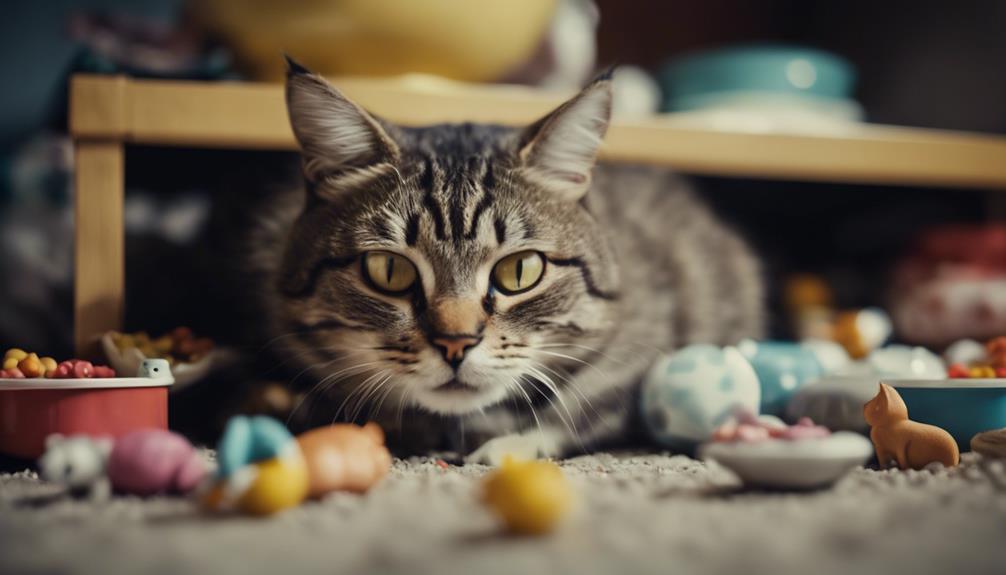
Often, a lonely cat may exhibit behavior of being withdrawn or hiding from their owners and other pets. This withdrawal can be indicative of an underlying sense of loneliness or discomfort. Here are some behavioral observations that may suggest your cat is feeling lonely:
- Increased Hiding: If your cat is spending more time hiding in unusual spots or retreating to secluded areas of the house, it could be a sign of loneliness. Cats often seek solitude when feeling overwhelmed emotionally.
- Avoiding Interaction: Cats are typically social animals and enjoy interacting with their owners. If your cat starts avoiding interactions, such as refusing to play or be petted, it might be a sign of loneliness.
- Changes in Body Language: Pay attention to your cat's body language. Signs like flattened ears, a tucked tail, or dilated pupils can indicate stress or loneliness. Understanding these subtle cues can help you identify if your cat is feeling lonely and in need of companionship.
Loss of Appetite

If your cat is experiencing loneliness, one potential indicator to watch for is a loss of appetite. Loss of appetite in cats can be a sign of various underlying issues, including emotional distress. Apart from weight loss, other symptoms such as lethargy, decreased grooming, and seeking isolation may accompany a decreased appetite. Here is a table highlighting some key signs associated with a cat's loss of appetite:
| Signs of Loss of Appetite |
|---|
| Weight Loss |
| Lethargy |
| Decreased Grooming |
| Isolation |
Weight loss is a concerning symptom often linked to a lack of eating, which can further exacerbate your cat's health. Lethargy, or a lack of energy, can also be observed when a cat is not consuming enough food. Additionally, decreased grooming and seeking isolation could signify that your cat is feeling lonely or unwell. If you notice these signs, it is essential to consult with a veterinarian to address any potential issues promptly.
Seeking Constant Attention
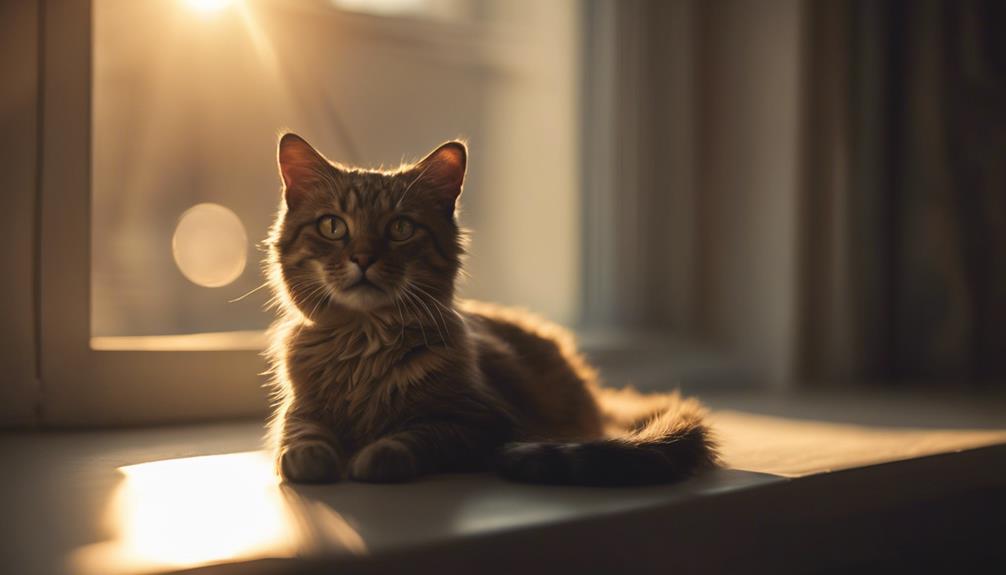
When a cat is lonely, it may exhibit behavior such as constantly seeking attention from its owners. This behavior can manifest in various ways, including meowing excessively, rubbing against their owners, or even following them around the house.
To help alleviate your cat's loneliness and fulfill its need for attention, consider the following:
- Playtime activities: Engaging in interactive play sessions with your cat can help provide mental stimulation and physical exercise. Use toys that encourage your cat to chase, pounce, and jump to keep them entertained and mentally engaged.
- Interactive toys: Interactive toys, such as puzzle feeders or toys that dispense treats, can help keep your cat occupied and mentally stimulated when you're not available to play with them. These toys can provide hours of entertainment and help prevent boredom and loneliness.
- Quality time: Spending quality time with your cat, whether it's through grooming, cuddling, or simply being in the same room, can help strengthen your bond and make your cat feel loved and cared for. Regular interaction and attention can go a long way in addressing your cat's loneliness.
Frequently Asked Questions
Can Getting Another Cat Help Alleviate My Cat's Loneliness?
Having another cat can provide playtime buddies and foster feline friendships, potentially alleviating loneliness. It's important to introduce the new cat properly and ensure both cats have enough space and resources to coexist harmoniously.
How Can I Tell if My Cat Is Feeling Lonely Versus Just Being Independent?
Ever wonder what your cat truly feels? Behavioral cues and body language are key. Interactive toys and enrichment activities can provide clues. Understanding these signals helps decipher between loneliness and independence in your feline friend.
Are There Specific Breeds of Cats That Are More Prone to Loneliness?
Certain cat breeds exhibit a higher propensity for loneliness due to their need for social interaction. Behavioral signs like excessive meowing or withdrawal may indicate this. Providing environmental enrichment, companionship, and interactive toys can benefit these breeds.
Can Changes in My Own Routine or Schedule Contribute to My Cat's Loneliness?
Changes in one's routine or schedule can indeed impact a cat's loneliness. Bonding activities, enrichment toys, interactive play, and scheduled cuddle time are vital to alleviating this. Consistency in these areas helps maintain a strong human-feline connection.
How Can I Help My Cat Adjust to Being Alone for Longer Periods of Time?
To help a cat adjust to being alone for longer periods of time, one can provide interactive toys and enrichment activities to prevent boredom. Behavior modification techniques can also be used to address separation anxiety and promote well-being.











